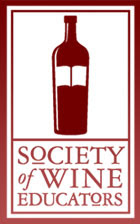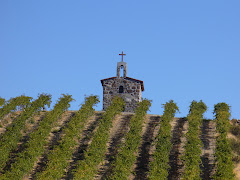Now, I know a lot of you folks out there don’t find too much to get excited about whenever us cork dorks talk about Riesling, but I have to tell you, there is nothing more amazing and more sublime than a well-made Riesling. Often thought of as a perfect food wine, Riesling has just the right amount of fruit and acidity to compliment most any dish, and depending upon how much body it possesses, the wine-food combination could very well be heaven on earth.
My wife and I drank two different Riesling with dinner – one very dry (Robert Weil Estate Dry Riesling 2006) and one more mature (von Hovel Riesling Kabinett Oberemmeler Hutte 2002). While the dry Riesling was fine, the more mature actually complimented the kabobs well (they were beef, by the way).
Why do I bring all this up? Well, whenever a customer asks, “what white wines would you most recommend?” I almost always say Riesling. And their reaction is almost always, “I don’t like sweet wines.” Damn that Blue Nun!
There are so many different nuances and complexities from German Rieslings, particularly the appellation specific releases – such as ones from the Rheingau, Mosel or Pfalz. Truly each area has a particular profile, such as the wet-stone notes in a Mosel, the fuller-bodied, richer flavors of the Rheingau, or the juicy, creamy taste of the Pfalz.
The biggest obstacle always seems to be the label of a German wine, which in essence, tries to convey all the information about the wine as possible, right on the bottle. You can determine just how sweet it will be as well as what its general flavor characteristics, just by reading the bottle.
For example, here is a label for the Zilliken Riesling Spatlese Saarburger Rausch:

Zilliken is first of all, found in the Mosel-Saar-Ruwer region of Germany. Mosel wines, as I said before, typically have a slate, wet stone quality to them. This particular Riesling is a Spatlese, which designates both the time the grapes were harvested as well as how sweet this wine is. On a sweetness scale (0 being bone dry through 5 being dessert-style sweet), this would be around a 2, so fairly sweet. The village-vineyard designation – Saarburger (the village of Saarburg) and Rausch (the vineyard) will usually indicate dusty, earthy notes.
Granted, this is not an exact science, not even close. Every producer has a different style, and every vintage yields many different, complex wines. Take the Zilliken wine for example. Here is David Schildknect’s (of Wine Advocate) tasting notes for the 2005 vintage: “A pungent nose of spiced apple, cherry, and white raisin leads into a palate whose creaminess adds allure, while not at all detracting from this Riesling’s fundamental delicacy and duty to refresh. Suggestions of apple peel, citrus rind, and slate add counterpoint to a rich yet refined finish of ravishing persistence. Drink 2007-2030.” Nothing really mentioning a lot of earthiness or dustiness, but there is mention of slate.
Though it won’t give it all away, once you taste a few German wines, you should start to get an idea of the differences in style. My suggestion to you is try a few – especially next time you do take out Chinese or Indian for dinner – and do a little experimenting, and I firmly believe that you will be another German wine convert.








No comments:
Post a Comment